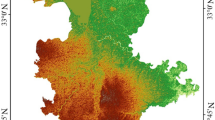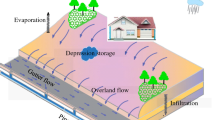Abstract
Understanding the hydrological effects of the Three Gorges Dam operation in the entire reservoir area is significant to achieving optimal dam regulation. In this paper, a large-scale coupled hydrological-hydrodynamic-dam operation model is developed to comprehensively evaluate the hydrological effects of the river-type Three Gorges Reservoir. The results show that the coupled model is effective for hydrological, hydrodynamic regime and hydropower simulations in the reservoir area. Dam operation could have a notable positive effect on flood control and could reduce the maximum daily flood peak by up to 26.2%. It also contributes a large amount of hydropower, approximately 94.27 TWh/year, and a water supply increase for the downstream area of up to 22% during the dry season. In the flood season, the water level at Cuntan would increase under the condition that the water level of the dam is higher than approximately 158 m due to dam operation. In the dry season, attention should be paid to the low flow velocity near the dam in the reservoir area.
Similar content being viewed by others
References
Baracchini T, Hummel S, Verlaan M et al., 2020. An automated calibration framework and open source tools for 3D lake hydrodynamic models. Environmental Modelling & Software, 134: 104787.
Bittner D, Narany T S, Kohl B et al., 2018. Modeling the hydrological impact of land use change in a dolomite-dominated karst system. Journal of Hydrology, 567: 267–279.
Botter G, Basso S, Porporato A et al., 2010. Natural streamflow regime alterations: Damming of the Piave river basin (Italy). Water Resources Research, 46(6): W06522.
Chai Y, Yang Y, Deng J et al., 2020. Evolution characteristics and drivers of the water level at an identical discharge in the Jingjiang reaches of the Yangtze River. Journal of Geographical Sciences, 30(10): 1633–1648.
Chen Q, Chen H, Zhang J et al., 2020. Impacts of climate change and LULC change on runoff in the Jinsha River Basin. Journal of Geographical Sciences, 30(1): 85–102.
Dai X, Yu Z, Yang G et al., 2021. Investigation of inner-basin variation: Impact of large reservoirs on water regimes of downstream water bodies. Hydrological Processes, 35(5): e14241.
Gao C, Ruan T, 2018. The influence of climate change and human activities on runoff in the middle reaches of the Huaihe River Basin, China. Journal of Geographical Sciences, 28(1): 79–92.
Gedney N, Cox P M, Betts R A et al., 2006. Detection of a direct carbon dioxide effect in continental river runoff records. Nature, 439: 835–838.
Guo C, Jin Z, Guo L et al., 2020. On the cumulative dam impact in the upper Changjiang River: Streamflow and sediment load changes. Catena, 184: 104250.
Guo S, Xiong L, Zha X et al., 2021. Impacts of the Three Gorges Dam on the streamflow fluctuations in the downstream region. Journal of Hydrology, 598: 126480.
Han C, Qin Y, Zheng B et al., 2020. Geochemistry of phosphorus release along transect of sediments from a tributary backwater zone in the Three Gorges Reservoir. Science of The Total Environment, 722: 136964.
Huang S, Xia J, Zeng S et al., 2021. Effect of Three Gorges Dam on Poyang Lake water level at daily scale based on machine learning. Journal of Geographical Sciences, 31(11): 1598–1614.
Huang Y, Wang J, Yang M, 2019. Unexpected sedimentation patterns upstream and downstream of the Three Gorges Reservoir: Future risks. International Journal of Sediment Research, 34: 108–117.
Jiang C, Zhang Q, Luo M, 2019. Assessing the effects of the Three Gorges Dam and upstream inflow change on the downstream flow regime during different operation periods of the dam. Hydrological Processes, 33: 2885–2897.
Jing Z, An W, Zhang S et al., 2020. Flood control ability of river-type reservoirs using stochastic flood simulation and dynamic capacity flood regulation. Journal of Cleaner Production, 257: 120809.
Lai X, Jiang J, Yang G et al., 2014. Should the Three Gorges Dam be blamed for the extremely low water levels in the middle-lower Yangtze River?. Hydrological Processes, 28: 150–160.
Lai X, Wang Z, 2017. Flood management of Dongting Lake after operation of Three Gorges Dam. Water Science and Engineering, 10: 303–310.
Li L, Xia J, Zhou M et al., 2020. Riverbed armoring and sediment exchange process in a sand-gravel bed reach after the Three Gorges Project operation. Acta Geophysica, 68: 243–252.
Li X, Liu B, Wang Y et al., 2020. Hydrodynamic and environmental characteristics of a tributary bay influenced by backwater jacking and intrusions from a main reservoir. Hydrology and Earth System Sciences, 24(11): 5057–5076.
Li Z, Ma J, Guo J et al., 2019. Water quality trends in the Three Gorges Reservoir region before and after impoundment (1992–2016). Ecohydrology & Hydrobiology, 19: 317–327.
Liro M, 2019. Dam reservoir backwater as a field-scale laboratory of human-induced changes in river biogeo-morphology: A review focused on gravel-bed rivers. Science of The Total Environment, 651: 2899–2912.
Liro M, Ruiz-Villanueva V, Mikuś P et al., 2020. Changes in the hydrodynamics of a mountain river induced by dam reservoir backwater. Science of The Total Environment, 744: 140555.
Liu P, Li L, Guo S et al., 2015. Optimal design of seasonal flood limited water levels and its application for the Three Gorges Reservoir. Journal of Hydrology, 527: 1045–1053.
Lyu J, Mo S, Luo P et al., 2019. A quantitative assessment of hydrological responses to climate change and human activities at spatiotemporal within a typical catchment on the Loess Plateau, China. Quaternary International, 527: 1–11.
Mei X, Dai Z, Darby S E et al., 2018. Modulation of extreme flood levels by impoundment significantly offset by floodplain loss downstream of the Three Gorges Dam. Geophysical Research Letters, 45: 3147–3155.
Mulatu C A, Crosato A, Langendoen E J et al., 2021. Long-term effects of dam operations for water supply to irrigation on downstream river reaches. The case of the Ribb River, Ethiopia. International Journal of River Basin Management, 19: 429–443.
Nilsson C, Reidy C A, Dynesius M et al., 2005. Fragmentation and flow regulation of the world’s large river systems. Science, 308: 405–408.
Pandey B K, Khare D, Kawasaki A et al., 2019. Climate change impact assessment on blue and green water by coupling of representative CMIP5 climate models with physical based hydrological model. Water Resources Management, 33: 141–158.
Poff N L, Matthews J H, 2013. Environmental flows in the Anthropocence: Past progress and future prospects. Current Opinion in Environmental Sustainability, 5(6): 667–675.
Qin P, Xu H, Liu M et al., 2020. Climate change impacts on Three Gorges Reservoir impoundment and hydropower generation. Journal of Hydrology, 580: 123922.
Qin P, Xu H, Liu M et al., 2022. Projected impacts of climate change on major dams in the Upper Yangtze River Basin. Climatic Change, 170(8).
Schmitt R J P, Kittner N, Kondolf G M et al., 2019. Deploy diverse renewables to save tropical rivers. Nature, 569: 330–332.
Su Z, Ho M, Hao Z et al., 2020. The impact of the Three Gorges Dam on summer streamflow in the Yangtze River Basin. Hydrological Processes, 34: 705–717.
Tang Q, Bao Y, He X et al., 2016. Flow regulation manipulates contemporary seasonal sedimentary dynamics in the reservoir fluctuation zone of the Three Gorges Reservoir, China. Science of The Total Environment, 548/549: 410–420.
Tian J, Chang J, Zhang Z et al., 2019. Influence of Three Gorges Dam on downstream low flow. Water, 11(1): 65.
Volke M A, Johnson W C, Dixon M D et al., 2019. Emerging reservoir delta-backwaters: Biophysical dynamics and riparian biodiversity. The Bulletin of the Ecological Society of America, 100(3): e01537.
Wang H, Sun F, Liu W, 2020. Characteristics of streamflow in the main stream of Changjiang River and the impact of the Three Gorges Dam. Catena, 189: 104498.
Wang J, Dai Z, Mei X et al., 2018. Immediately downstream effects of Three Gorges Dam on channel sandbars morphodynamics between Yichang-Chenglingji Reach of the Changjiang River, China. Journal of Geographical Sciences, 28(5): 629–646.
Wang K, Pang Y, He C et al., 2021. Three Gorges Reservoir construction induced dissolved organic matter chemistry variation between the reservoir and non-reservoir areas along the Xiangxi tributary. Science of The Total Environment, 784: 147095.
Wu H P, Chen J, Zeng G M et al., 2020. Effects of early dry season on habitat suitability for migratory birds in China’s two largest freshwater lake wetlands after the impoundment of Three Gorges Dam. Journal of Environmental Informatics, 36(2): 82–92.
Xia J, Wang G, Tan G et al., 2005. Development of distributed time-variant gain model for nonlinear hydrological systems. Science in China Series D: Earth Sciences, 48: 713–723.
Xiang R, Wang L, Li H et al., 2021. Water quality variation in tributaries of the Three Gorges Reservoir from 2000 to 2015. Water Research, 195: 116993.
Xu X, Tan Y, Yang G, 2013. Environmental impact assessments of the Three Gorges Project in China: Issues and interventions. Earth-Science Reviews, 124: 115–125.
Yang S L, Milliman J D, Xu K H et al., 2014. Downstream sedimentary and geomorphic impacts of the Three Gorges Dam on the Yangtze River. Earth-Science Reviews, 138: 469–486.
Yang Z, Liu D, Ji D et al., 2010. Influence of the impounding process of the Three Gorges Reservoir up to water level 172.5 m on water eutrophication in the Xiangxi Bay. Science China Technological Sciences, 53: 1114–1125.
Yang Y, Zhang M, Sun Z et al., 2018. The relationship between water level change and river channel geometry adjustment in the downstream of the Three Gorges Dam. Journal of Geographical Sciences, 28(12): 1975–1993.
Yang Y, Zhang M, Zhu L et al., 2017. Influence of large reservoir operation on water-levels and flows in reaches below dam: Case study of the Three Gorges Reservoir. Scientific Reports, 7(1): 15640.
Yin J, Gentine P, Zhou S et al., 2018. Large increase in global storm runoff extremes driven by climate and anthropogenic changes. Nature Communications, 9: 4389.
Yuan W, Yin D, Finlayson B et al., 2012. Assessing the potential for change in the middle Yangtze River channel following impoundment of the Three Gorges Dam. Geomorphology 147/148: 27–34.
Zarfl C, Lumsdon A E, Berlekamp J et al., 2015. A global boom in hydropower dam construction. Aquatic Sciences, 77: 161–170.
Zeng S, Du H, Xia J, 2020. Development of an interface-oriented add-in modeling framework for integrated water system simulation and its application. Environmental Modelling & Software, 134: 104840.
Zeng S, Du H, Xia J et al., 2022. Attributions of evapotranspiration and gross primary production changes in semi-arid region: A case study in the water source area of the Xiong’an New Area in North China. Remote Sensing, 14: 1187.
Zeng S, Xia J, Du H, 2014. Separating the effects of climate change and human activities on runoff over different time scales in the Zhang River basin. Stochastic Environmental Research and Risk Assessment, 28: 401–413.
Zhang J, Huang T, Chen L et al., 2020. Impact of the Three Gorges Reservoir on the hydrologic regime of the river-lake system in the middle Yangtze River. Journal of Cleaner Production, 258: 121004.
Zhang Q, Li L, Wang Y G et al., 2012. Has the Three-Gorges Dam made the Poyang Lake wetlands wetter and drier? Geophysical Research Letters, 39(20): L00402.
Zhang Q, Zhou Y, Singh V P et al., 2012. The influence of dam and lakes on the Yangtze River streamflow: Long-range correlation and complexity analyses. Hydrological Processes, 26: 436–444.
Zhang S, Hua D, Meng X et al., 2011. Climate change and its driving effect on the runoff in the “Three-River Headwaters” region. Journal of Geographical Sciences, 21(6): 963–978.
Funding
Strategic Priority Research Program of the Chinese Academy of Sciences, No.XDA23040500; Youth Innovation Promotion Association, CAS, No.2021385; Central Guidance on Local Science and Technology Development Fund of Chongqing City, No.2021000069
Author information
Authors and Affiliations
Corresponding author
Additional information
Author
Zeng Sidong (1987–), Associate Professor
Corresponding author
Du Hong (1988–), Lecturer
Rights and permissions
About this article
Cite this article
Zeng, S., Liu, X., Xia, J. et al. Evaluating the hydrological effects of the Three Gorges Reservoir based on a large-scale coupled hydrological-hydrodynamic-dam operation model. J. Geogr. Sci. 33, 999–1022 (2023). https://doi.org/10.1007/s11442-023-2117-7
Received:
Accepted:
Published:
Issue Date:
DOI: https://doi.org/10.1007/s11442-023-2117-7




